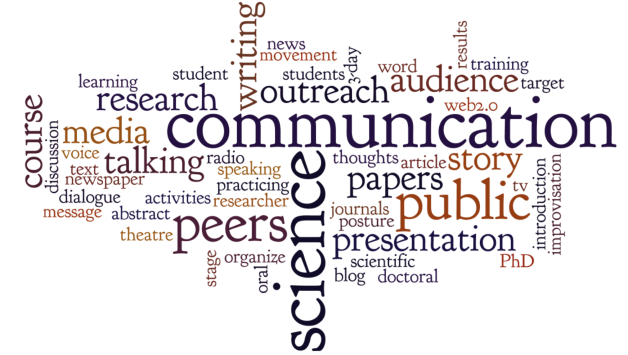
If I could create a personal word cloud, ‘COMMUNICATION’ would scream out of the middle of it in huge letters. I have spoken, typed, written, drawn and gestured this word multiple times a day in my professional life. During speech and language therapy training, I studied communication in its many forms: spoken, written, non-verbal, dance (well, I remember the bees waggle dance featuring in one first year lecture). It then became the bread and butter of my work as a speech and language therapist; supporting people who have difficulty speaking or writing to communicate effectively is one of the fundamental skills of my trade. More recently, I found ‘communication’ taking more prominence in my life outside of work. Where once day-to-day communication was something I did without much thought – usually face to face, occasionally in writing – new platforms emerged; each requiring attention to style, with an individual set of interaction rules and an expectation of regular updates. Social media, text-messaging, emails, and blogging, to name a few. “How shall I phrase that?”, “Which emoji best represents how I feel?”, “Does this picture sum up my experience here?”, “How can I write this in 140 characters?”. There were so many novel ways to express opinions and experiences, communication suddenly required consideration in my personal as well as my professional life. Although fascinated by communication (hence my career choice) and able to support others to communicate, I found adopting these new modes of communication challenging. I have learnt to engage with social media platforms, but it has been a slow process.
And now I find that a new set of communication skills is required. One element of my academic training is developing and implementing an effective communication strategy. In order to share my learning, research and to build collaborations for the future, I must connect effectively with stakeholders: my supervisory team, the project advisory group, professionals working in the field of communication aids, my speech and language therapy department and colleagues, participants, recruitment sites, funders, sponsors, the university,… the list goes on. I need to be proficient at communicating with academics, clinicians, experts and members of the public with experience of using communication aids. I also aspire be able to engage and interest people who aren’t aware of communication aids, to raise their awareness of the challenges that people who rely on them face. Twitter has opened up the possibility of networking with people who I don’t know and may never meet but with whom I share a professional interest. I find it difficult to judge what, where and when to tweet however, and am still learning how to precis my thoughts into 140 characters. This blog is my attempt to articulate my research journey to a wider, non-expert but interested audience. Writing for an unknown reader is another communication challenge. How much knowledge should I assume? How do I come across in writing to people who don’t know me? Is my writing clear and accessible? Academic journals are a key mechanism for sharing research, especially within professional and academic communities, yet require a different style of written expression again. Having spent over a year writing one paper for submission to a journal, I then found myself spending days, weeks even, formatting the document so it meets with the journal-specific style requirements.
I started this journey thinking that I was an expert in communication but the terms of reference have shifted. Communication is key to sharing my project with the widest possible audience, to develop a network that will support me on my clinical academic journey and to build a profile as a researcher. But I am no longer the communication specialist; I am a student again.